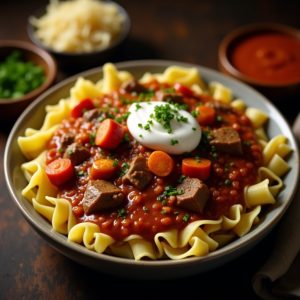
AI generated image
Chef's Tip
The key to developing rich flavor in goulash is properly browning the meat in batches without overcrowding the pan. This creates the foundational flavor through the Maillard reaction. Also, be sure to toast the paprika briefly in the oil to bloom its flavor, but watch carefully as it can burn quickly and become bitter.
Instructions
- Season beef cubes with 1 tsp salt and black pepper. Heat 2 tbsp oil in a large Dutch oven over medium-high heat.
- Working in batches, brown the beef on all sides, about 3-4 minutes per batch. Transfer browned meat to a plate.
- Add remaining 1 tbsp oil to the pot. Add onions and bell pepper, cooking until softened, about 5 minutes.
- Add garlic and cook until fragrant, about 30 seconds. Stir in both sweet and hot paprika, caraway seeds, and flour. Cook, stirring constantly, for 1 minute.
- Add tomato paste and cook, stirring, for another minute.
- Slowly add beef broth, stirring constantly to prevent lumps. Return beef to the pot along with any accumulated juices.
- Add bay leaves, bring to a boil, then reduce heat to maintain a gentle simmer. Cover and cook for 1 hour, stirring occasionally.
- Add potatoes and carrots, along with the remaining 1 tsp salt. Cover and continue simmering until beef and vegetables are tender, about 45-60 minutes more.
- When goulash is nearly done, cook egg noodles according to package directions. Drain and toss with butter and 2 tbsp chopped parsley.
- Warm sauerkraut in a small saucepan over medium heat until heated through.
- Taste goulash and adjust seasoning with salt and pepper as needed. Remove bay leaves before serving.
- Serve goulash over buttered noodles with a dollop of sour cream, a sprinkling of remaining parsley, and sauerkraut on the side.
Plating
Place a mound of buttered egg noodles in the center of a deep bowl or plate. Ladle the goulash generously over the noodles. Add a dollop of sour cream on top and sprinkle with fresh parsley. Serve with a side of warm sauerkraut in a separate small dish or directly on the plate.
Storage & Reheating
Goulash actually improves in flavor when stored. Refrigerate in an airtight container for up to 4 days or freeze for up to 3 months. Reheat gently on the stovetop, adding a splash of broth if needed to thin the sauce. Store noodles separately, as they will absorb the sauce and become mushy if combined during storage.
About This Recipe
This beef goulash draws inspiration from the Hungarian Beef Goulash served at The Student Prince restaurant. The home version celebrates the distinctive paprika-forward flavor profile that defines this classic Central European stew. Long, slow simmering allows the beef to become tender while the sauce develops a rich, complex flavor that pairs perfectly with simple buttered noodles.
